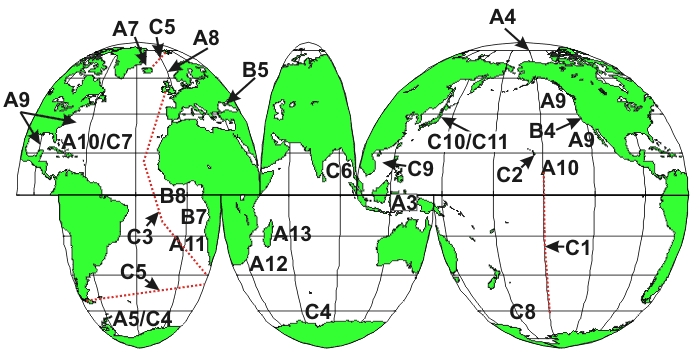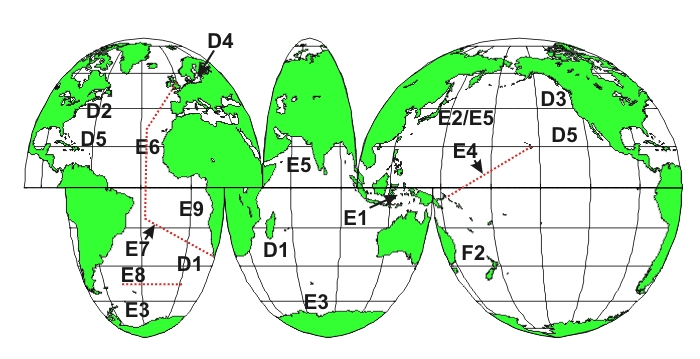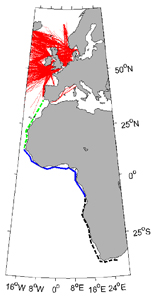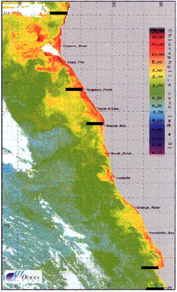Cooperating Projects
|
Interactive Map Sampling zooplankton in many ocean regions are accomplished during the first years of the
CMarZ project by coordinating with ongoing, planned, and proposed programs, surveys, and initiatives. Top map: funded projects Bottom map: planned projects
CMarZ Cruises during 2004 – 2006CMarZ cruises completed during 2004 – 2006:CMarZ-related cruises were carried out during 2004-2006 to the following regions. Cruises are listed by cooperating project designations: A and B refer to field efforts described in the CMarZ Science Plan; C refers to projects not previously described. Missing numbers are projects that did not involve field work or projects that were not completed as proposed. A3. SW Pacific Ocean: Coastal ecosystems of Indonesia, incuding Spermonde Archipelago, Strait of Makassar, SW Sulawesi, with sampling from small boats. Research topics include zooplankton diversity, distribution, abundance, community structure, and benthic-pelagic coupling. Sampling will be done with small plankton nets (Apstein, Nansen), with phytoplankton collection and hydrographic analysis, during Spring and Fall, 2005. [CMarZ contact: Sigrid Schiel] A4. Arctic Ocean: Sampling done in association with ArcOD. [CMarZ contact: Russ Hopcroft] A5. Antarctic / Southern Ocean: Cruise to sample in the western Weddell Sea from the RV Polarstern during November 2004 - January 2005. [CMarZ contact: Sigrid Schiel] A7. Nordic Seas: Icelandic and Norwegian Seas were sampled during a herring survey by the Marine Research Institute on the R/V Árni Fridriksson during 17 – 30 May 2005. Icelandic and Irminger Seas were sampled during the MRI Spring Survey during 18-28 May 2005. See http://www.hafro.is/index_eng.php. [CMarZ contact: Astthor Gislason, Institute of Marine Research, Iceland]
A9. NW Atlantic / NE Pacific: Ecosystem monitoring over USA continental shelf regions is carried out by the US National Marine Fisheries Service from survey vessels on the northeast US continental shelf, in the Gulf of Mexico, on the California continental shelf, and off coastal Alaska. Surveys by R/V Albatross have yielded samples for CMarZ from the Gulf of Maine, NW Atlantic Ocean, at 3 month intervals during 2004 - 2006. [CMarZ contact: Ann Bucklin] A10a. Mid-Pacific Oceans: During 2005, SEA sailing vessel SSV Robert C. Seamans sailed extensively in the central Pacific Ocean, collecting surface zooplankton samples in regions rarely sampled by oceanographic research vessels. [CMarZ contact: Peter Wiebe] >A10b. NW Atlantic Ocean: The SEA (Sea Education Association, Woods Hole, MA) vessel SSV Corwith Cramer collected samples in right whale feeding grounds in the Slope Water and in the Gulf of Maine and in the Sargasso Sea. [CMarZ contact: Peter Wiebe]
B7. SE. Atlantic Ocean: Pelagic fisheries recruitment survey during May - June 2005; and spawning biomass survey during November 2005, off west and south coasts of South Africa. [CMarZ contact: Hans Verheye] B8. SE. Atlantic Ocean: Alexander von Humboldt – Angola-Benguela (AHAB) Research and Training Expedition off SW Africa, with sampling of the Angola-Benguela Front during January-February 2004, and off central Namibia during April 2004. [CMarZ contact: Hans Verheye] C1. Mid-Pacific Ocean: Cruise of the Hakuho-Maru (KH-04-5) during November 2004 to March 2005 from the Antarctic to tropical North Pacific along 170oW longitude. [CMarZ contact: Shuhei Nishida] C2. N Pacific Ocean: HOT (Hawaii Ocean Time Series) cruise #169 during May 16 – 20, 2005. Several net tows were conducted to collect coccolithophores. See http://hahana.soest.hawaii.edu/hot/csreports/cs169.pdf. [CMarZ contact: Colomban de Vargas] C3. Eastern Atlantic Ocean: Atlantic Meridian Transect cruise #16 sampled from Cape Town, South Africa to Falmouth, UK during May and June, 2005. See http://www.pml.ac.uk/amt. [CMarZ contact: Colomban de Vargas C4. Antarctic/Southern Ocean: Zooplankton sampling was carried out during four cruise legs of the R/V Polarstern: Lazarev Sea (November 2005 - January 2006 and June – August 2006); Bellingshausen Sea (February – April 2006 ); and western Weddell Sea (August – October 2006) [CMarZ contact: Sigrid Schiel] C5. Antarctic / Arctic: Zooplankton sampling during 2006 included a transect across the South Atlantic from Punta Arenas to Cape Town on the RV Polarstern and a transect across the Greenland Sea from Longyearbyen, Svalbard to Reykjavik, Iceland on the RV Merian. The study, funded by German Science Foundation (DFG), evaluated speciation processes and ecological niches of deep-sea copepods in polar seas. [CMarZ contacts: Sigi Schiel and Holger Auel, University of Bremen, Germany] C6. Indian Ocean: The French program OISO provided opportunities for CMarZ sampling of zooplankton in the Indian Ocean. The lead for this program is Nicolas Metzl. (see http://www.ipsl.jussieu.fr) [CMarZ contact: Colomban de Vargas] C7. NW Atlantic Ocean: Comprehensive biodiversity survey of deep waters of the western Atlantic (Sargasso Sea). Collections were made using nets from meso- and bathypelagic waters. Funded by the NOAA Ocean Exploration Program, the cruise took place during April 10 – 30, 2006. Further details and photos.[CMarZ contacts: Peter Wiebe, Larry Madin, and Ann Bucklin] C8. Antarctic/Southern Ocean: The Chinese Antarctic Expedition during February/March 2006 yielded zooplankton samples for taxonomic analysis through CMarZ. Identified specimens are being DNA barcoded. [CMarZ contact: Sun Song] C9. NW Pacific Ocean: Zooplankton sampling was done with a conical opening/closing net during April 10-29 2006 on the R/V Beidou. [CMarZ contact: Sun Song] C10. NW Pacific Ocean: A research cruise in Sagami Bay, coastal waters of Japan, sampled zooplankton for taxonomic analysis during November/December 2005. [CMarZ contact: Shuhei Nishida] C11. NW Pacific Ocean: Species variability and depth adaptation of zooplankton was studied during a cruise of the Tansei Maru during June 2006. [CMarZ contacts: Ryuji Machida, Colomban de Vargas]
Time-series projects: CMarZ is collaborating with organizations or projects that conduct regular monitoring or time-series collections. The following list includes sources of zooplankton samples over the 2006 – 2009 time period. D1. SE Atlantic and SW Indian Oceans: Continued sampling during annual fisheries stock assessment cruises and monthly environmental monitoring cruises, as well as dedicated research and training cruises, during 2006-2009. Specimens will be identified and sent to the University of Connecticut for DNA barcoding. [CMarZ contact: Hans Verheye] D2. NW Atlantic / NE Pacific: Ecosystem monitoring over USA continental shelf regions is carried out by the US National Marine Fisheries Service from survey vessels on the northeast US continental shelf, in the Gulf of Mexico, on the California continental shelf, and off coastal Alaska. [CMarZ contact: Ann Bucklin] D3. N Pacific Ocean: Regular cruises for sampling in coastal regions of the Gulf of Alaska along the US GLOBEC “Seward Line”. Cruises are planned for September and May of 2006, 2007, and 2008 [CMarZ contact: Russ Hopcroft] D4. NW Atlantic / Baltic Sea: A time-series collection begun in 1957 at a shallow station in the Gulf of Riga will be continued by Henn Ojaveer (Estonian Marine Institute, University of Tartu, Estonia), who will oversee an effort to analyze the data for species diversity and abundance/biomass dynamics. New collections will be made to evaluate sampling methods. [CMarZ contact: Ann Bucklin] D5. N. Pacific / N. Atlantic Oceans: During 2006 – 2009, vessels of the SEA (Sea Education Association, Woods Hole, MA USA) will sail extensively through the N. Pacific and N. Atlantic Oceans, collecting surface zooplankton samples in regions rarely sampled by oceanographic research vessels. The sailing vessels SSV Robert C. Seamans and SSV Corwith Cramer carry students and teachers on educational cruises. Lessons include material from CMarZ. [CMarZ contact: Peter Wiebe] Oceanographic research cruises: Cruises listed here are part of funded cooperating projects and/or cruises for which samples will be collected on an ancillary basis for CMarZ. Cruises that are part of proposed or unfunded projects are listed in the next section (F). E1. SE Asia: Samples will be collected using nets and ROV during an expedition to Malyasian waters during 2007. Funded by NOAA Ocean Exploration, the National Geographic Society and Conservation International, the project is titled “Inner-space Speciation Project”. [CMarZ contact: Larry Madin] E2. NW Pacific Ocean: An educational cruise for Japanese high school students, Let's study the sea with research vessel will take place during July 31 – August 5, 2006. The cruise is sponsored by the Japan Science Society, Oceanographic Society of Japan, and Tokai University (Japan). [CMarZ contact: Ryuji Machida] E3. Antarctic/Southern Ocean: Lazarev and N. Weddell Seas will be sampled during June/August and August/October 2006 on the R/V Polarstern. Zooplankton will be captured by Multinet down to 2000. [CMarZ contact: Sigi Schiel] E4. Equatorial W. Pacific Ocean: Cruise led by James Murray (Univ. Washington, USA) will transect from Hawaii to Papua New Guinea (140oW to 148oE) on the R/V Kilo Moana to sample water column and organisms for heavy metals, with ancillary sampling for CMarZ at 5 – 10 stations. Cruise dates are August 15 – October 1, 2006. [CMarZ contact: Ann Bucklin] E5. Indian Ocean: DNA barcoding of the copepod fauna of estuaries and coastal waters along the central west coast of India. Taxonomic analysis of calanoid copepods will be done by S.C. E6. N. Atlantic Ocean: Sampling from the subtropical NE Atlantic in the NW African upwelling region, during July to August 2006 from the R/V Meteor. Sampling will be done by WP2 net from 0 - 100 m. [CMarZ contact: Sigi Schiel] E7. N and S Atlantic Ocean: A north-to-south latitudinal transect throughout the Atlantic Ocean is planned for October/November 2007 or March/April 2008. Sampling from the R/V Polarstern will be done with a Multinet, including deep samples below 2000m. [CMarZ contact: Sigi Schiel] E8. S Atlantic Ocean: A west-to-east transect will be sampled along 51°S during April-June 2006 from the R/V Polarstern. In a project led by Holger Auel (University of Bremen, Germany), zooplankton will be collected using a Multinet from 0 - 2000 m, with samples preserved in formaldehyde and ethanol. [CMarZ contact: Sigi Schiel] E9. S Atlantic Ocean: Sampling in the Benguela Upwelling Region during March/April 2008 from the R/V Meteor will be done using a Multinet to sample down to 2000 m. Project leader is Holger Auel from the University of Bremen, Germany. [CMarZ contact: Sigi Schiel] Proposed research cruises: These cruises are field components of pending proposals or projects awaiting approval. F1. SE Asia and NE Pacific: Comprehensive survey of zooplankton biodiversity during 2007/2008. Collections will be made using nets, ROVs, and submersibles, as part of a field effort to be proposed to the Japan Society for the Promotion of Science. [CMarZ contact: Shuhei Nishida] F2. South Pacific: A field sampling opportunity in and around Australia and the South Pacific in 2007 and 2008 is offered by Graham Short, owner of the 60-foot ketch Mustang. Further details. [CMarZ contact: Ann Bucklin]
Cooperating Projects 2004 – 2006: Several laboratory-based cooperating projects were completed during 2004 – 2006, the first two years of CMarZ: B1. World Radiolarian Distributional Database (WoRaDD): This project is compiling all the existing (published and unpublished) information on radiolarian (Polycystina) distributions from plankton and sediment trap samples, and from surface sediment materials. To date, 95% of the taxonomic and distributional data available – nearly 300,000 records – have been accessed from ~100 different sources. The second phase of the work, the critical analysis and cleaning of the database, is beginning now. [CMarZ contact: Demetrio Boltovskoy] B3. Calcareous Plankton Ocean Biogeographical Information System (CalcOBIS): The CalcOBIS database is an interactive biogeographical system that will provide global taxonomic and phylogenetic information at the morphological and genetic species levels for all calcareous skeleton-bearing taxa in the marine zooplankton (foraminifers, tintinnids, pteropods, ostracods, heteropods). [CMarZ contact: Colomban de Vargas] B4. International Indian Ocean Expedition (IIOE) data digitization: This project has digitized station locations and other details for 1,548 collections made throughout the Indian Ocean. Zooplankton biomass, total population, and population density for all the taxa were collated and computerized. Data for 21 chaetognath and 26 ostracod species were digitized. [CMarZ contact: Vijayalakshmi Nair] Planned Cooperating Projects 2006 – 2009: Several cooperating projects are planned for the renewal period. These projects are considered to be laboratory-based, although they may entail field collecting: G1. DNA Barcoding: Laboratories associated with CMarZ and equipped for molecular analyses (including DNA sequencing) will coordinate to ensure storage, archiving, and molecular systematic analysis of specimens sent by CMarZ researchers, who may be focused on taxonomic, morphological, or ecological studies. A DNA sequence appropriate for species identification and discovery (i.e., a DNA barcode, Hebert et al. 2003, Stoeckle 2003) will be selected for each zooplankton taxon. Specimens will be sequenced within a reasonable time frame, and the DNA sequences submitted to the GenBank molecular database (http://www.ncbi.nlm.nih.gov). Voucher specimens and voucher DNA will be permanently maintained by the molecular laboratory, and will be accessible for further study. [CMarZ contacts: Ann Bucklin and Shuhei Nishida] G2. Calanoides carinatus ZooGene Project (CCZP). This project seeks to determine the taxonomic limits of the polymorphic copepod species, Calanoides carinatus, using coordinated morphological and molecular analysis of specimens from the N. and S. Atlantic Ocean. This effort was designed and led by Maria Delia Vinas (INIDEP, Argentina). [CMarZ contacts: Ann Bucklin and Hans Verheye] G3. Deep phylogeny of Calanoid copepods: This collaboration compares morphological and molecular evidence of the relationships among calanoid copepods. Molecular analysis includes DNA barcoding for mtCOI as well as analysis of DNA sequence variation for more slowly-evolving genes revealing deeper evolutionary relationships. [CMarZ contacts: Janet Bradford-Grieve, Shuhei Nishida, Ann Bucklin] G4. International Indian Ocean Expedition (IIOE) data digitization: This continuation of an ongoing project will produce digitized inventories for major groups of zooplankton in the Indian Ocean, including chaetognaths, copepods, ostracods, mysids, and fish larvae. Each inventory will cover complete morphological descriptions of species, known biological distributions, and a comprehensive bibliography. This information will be incorporated into CMarZ Species Pages. [CMarZ contact: Vijayalakshmi Nair]
Additional Cooperative Research (not mapped)annual. NOAA National Marine Fisheries Service (US government) Zooplankton sampling from NMFS Ecosystem Monitoring Surveys. [contact: D. Mountain] 2007. Thomas Kiorboe's lab in Denmark. Samples of coastal copepods were extracted for contribution to an analysis by Erica Goetze while she was working at Thomas Kiorboe's lab in Denmark on genetics of marine planktonic copepods. [contact: S. Hay and E. Goetze] 2008. R. Gudmundsdottir, pre-doctoral student of CMarZ Network member, Fredrica Norrbin (University of Tromsoe, Norway), visited the University of Connecticut during July and August 2008. She learned basic molecular and DNA barcoding techniques, and used sequences for the barcode gene, mitochondrial cytochrome oxidase I (mtCOI) to design a multiplexed species-specific PCR (SS-PCR) protocol to identify and discriminate several difficult-to-identify or cryptic species of the calanoid copepod genus, Pseudocalanus, from the northern North Atlantic Ocean and Baltic Sea. [contact: A. Bucklin] 2008. A. Cornils (CMarZ-Europe Project Manager and a postdoctoral fellow at the Alfred Wegener Institute, Germany) and A. Pierrot-Bults visited the University of Connecticut during September-October, 2008. Astrid learned DNA barcoding techniques and analyzed calanoid copepods from the FS Polarstern cruise in 2007. During this time, Astrid travelled to the Woods Hole Oceanographic Institution to participate in a CMarZ Synthesis Working Group meeting on DNA barcoding. [contact: A. Bucklin, and A. Pierrot-Bults] 2008. Japan Society for the Promotion of Science (JSPS) Post-Oil Spill Monitoring; funded by Philippine Government; cooperating with JSPS and CMarZ on zooplankton monitoring in Central Philippines. [contact: W. L. Campos, (PI) and S. Nishida] 2008. CMarZ and ArcOD Joint barcoding effort. [contact: A. Bucklin] 2008. Zoology Museum Amsterdam The diversity and spatial distribution of the Paracalanidae (Copepoda: Crustacea) in Indonesian Seas. Visiting the Zoology Museum Amsterdam. Host: Annelies Pierrot-Bults. [contact: A. Cornils] 2008. National Institute of Water & Atmospheric Research, New Zealand (NIWA) and Universidad de Concepcion During 2008 and as a product of the joint work during the Polarstern cruise in October 2007, a very active collaboration between Janet Bradford from New Zealand and our zooplankton laboratory was developed, and have allowed us to clarify the identification status for some abundant copepods of the Chilean coast. [contact: R. Escribano and J. Grieve] 2008. National Institute of Water & Atmospheric Research, New Zealand (NIWA) and Alfred Wegener Institute for Polar and Ocean Research (AWI) Specimens of male calanoid copepod, Mecynocera clausi, made available on Polarstern by Prof. Sigrid Schiel, were analysed and discovered to be members of the family Paracalanidae, not a separate family, as currently accepted. [contact: J. Grieve and S. Schiel] 2008. Ocean Research Institute, University of Tokyo Data Integration and Assimilation System (DIAS). A government project aiming at integrating and assimilating data on global environment, including those on plankton biodiversity. [contact: T. Koike, (PI) and S. Nishida] 2008. Monterey Bay Aquarium Research Institute (MBARI) and Japan Agency for Marine-Earth Science and Technology (JAMSTEC) Development of a software-hardware system to recognize and classify zooplankton in video transects with Bruce Robison, Midwater Biology. [contact: D. Lindsay] 2008. Ryuji Machida (Ocean Research Institute, University of Tokyo and CMarZ-Asia Project Manager) received CMarZ support for travel to the Woods Hole Oceanographic Institution, USA to participate in a CMarZ Synthesis Working Group meeting on DNA barcoding during October 2008. [contact: R. Machida] 2008. Japan Society for the Promotion of Science (JSPS) Japan Society for the Promotion of Science (JSPS): Multilateral Program- Coastal Marine Science; cooperating with CMarZ on biodiversity of zooplankton in SE Asia; related CoML projects are NaGISA and TOPP. [contact: M. Miyazaki, (PI) and S. Nishida] 2008. Japan Society for the Promotion of Science (JSPS) Research Center for Biology, Indonesian Institute of Science (LIPI); cooperating with JSPS and CMarZ on zooplankton biodiversity in SE Asia. [contact: Mulyadi, S. Scientist and S. Nishida] 2008. Japan Society for the Promotion of Science (JSPS) Vietnam Academy of Science and Technology (VAST) Project- Ecology and Fisheries of Giant Jellyfishes in Vietnam; cooperating with JSPS and CMarZ on the ecology and fisheries of giant jellyfishes in Vietnam. [contact: T. T. Nguyen, (PI) and S. Nishida] 2008. Japan Society for the Promotion of Science (JSPS) Japan Society for the Promotion of Science (JSPS): Bilateral Project- Biodiversity and Ecological roles of medusae and ctenophores in Indonesian waters; cooperating with CMarZ on jellyfish diversity in SE Asia; Ohtsuka, S. and Mulyadi (co PIs). [contact: S. Ohtsuka, Mulyadi, (co-PIs) and S. Nishida] 2008. Japan Society for the Promotion of Science (JSPS) Research Project in Malaysia- Integrated Research of Priority Area (IPRA), funded by Government of Malaysia; cooperating with JSPS and CMarZ on zooplankton biodiversity in Malaysia; Othman, B.H.R (PI). [contact: B. H. R. Othman, (PI) and S. Nishida] 2008. Chinese Academy of Sciences and KLMEES, Institute of Oceanology, Qingdao, China Zooplankton sampling from Open Science Cruise organized annually by the IOCAS. [contact: Song SUN] 2008. Observatoire Oceanologique, Villefranche sur mer, France. X. Sun awarded a Wang Kuancheng fellowship on "Usage of zooscan in the study of zooplankton diversity". The fellowship allowed her to carry out zooplankton biodiversity research during her 3-month visit to Gabriel Gorsky's laboratory at Observatoire Oceanologique. [contact: X. Sun] 2008. Marine and Coastal Management, Dept of Environmental Affairs and Tourism (South African government) Zooplankton sampling during annual fish stock assessments, monthly environmental monitoring programs, and dedicated research cruises. [contact: H. Verheye] 2008. National Marine Information and Research Centre, Ministry of Fisheries and Marine Resources (Namibian government) Anja Kreiner, Environmental Section (Biological Oceanography), Swakopmund, Namibia. Zooplankton sampling during annual fisheries surveys and monthly environmental monitoring programs. [contact: H. Verheye] 2008. National Fisheries Research Institute (Angolan government) Agulhas-Somali Currents Large Marine Ecosystem - ASCLME Antonio da Silva, Luanda, Angola; Zooplankton sampling during monthly environmental monitoring programs. Zooplankton sampling during dedicated research cruises. [contact: H. Verheye] 2009-2011. University of Hawai'i at Manoa. Sampling of estuarine zooplankton around Oahu, Hawaii with special focus on time series data from Kaneohe Bay. Hawaii Sea Grant Project. [contact: E. Goetze and P. Lenz] |
||||||||||||||||



